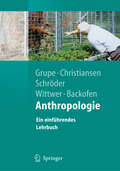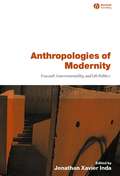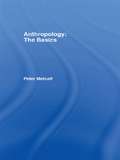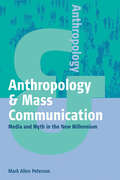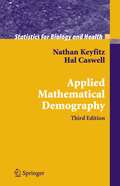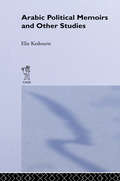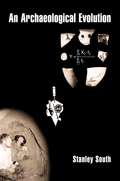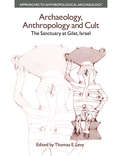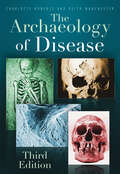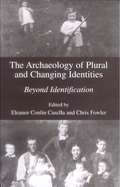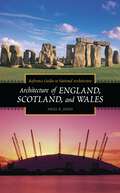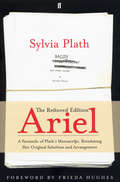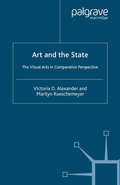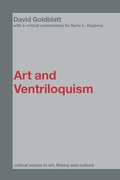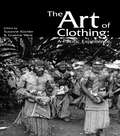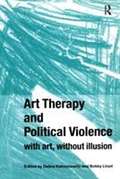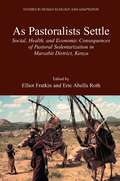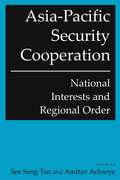- Table View
- List View
Anthropologie: Ein einführendes Lehrbuch (Springer-Lehrbuch)
by Gisela Grupe Kerrin Christiansen Inge Schröder Ursula Wittwer-BackofenDie Anthropologie versteht sich hier als Brückenfach zwischen Natur- und Geisteswissenschaften. Sie schließt auch die nächsten Verwandten der Menschen im Tierreich, die nicht-menschlichen Primaten, mit ein. Diese Einführung vermittelt die ganze fachliche Breite im Grundstudium. Basierend auf einem Vorschlag der „Gesellschaft für Anthropologie e.V.“
Anthropologies of Modernity: Foucault, Governmentality, and Life Politics
by Jonathan Xavier IndaThis book brings together a range of anthropological writings that are inspired by the French philosopher Michel Foucault and examine Foucault’s contribution to current theories of modernity. Treats modernity as an ethnographic object by focusing on its concrete manifestations. Tackles issues of broad interest: from colonialism and globalization to war, genetics, and AIDS. Draws on work from North and South America, Europe, Africa, and South and Southeast Asia. Contributors include James Ferguson, Akhil Gupta, Aihwa Ong, Paul Rabinow, and Rayna Rapp.
Anthropology: The Basics (The Basics)
by Peter MetcalfThe ultimate guide for the student encountering anthropology for the first time, Anthropology: The Basics explains and explores key anthropological concepts including: what is anthropology? how can we distinguish cultural differences from physical ones? what is culture, anyway? how do anthropologists study culture? what are the key theories and approaches used today? How has the discipline changed over time? This student-friendly text provides an overview of the fundamental principles of anthropology and is an invaluable guide for anyone wanting to learn more about this fascinating subject.
Anthropology: The Basics (The Basics)
by Peter MetcalfThe ultimate guide for the student encountering anthropology for the first time, Anthropology: The Basics explains and explores key anthropological concepts including: what is anthropology? how can we distinguish cultural differences from physical ones? what is culture, anyway? how do anthropologists study culture? what are the key theories and approaches used today? How has the discipline changed over time? This student-friendly text provides an overview of the fundamental principles of anthropology and is an invaluable guide for anyone wanting to learn more about this fascinating subject.
Anthropology and Mass Communication: Media and Myth in the New Millennium (Anthropology & ... #2)
by Mark Allen PetersonAnthropological interest in mass communication and media has exploded in the last two decades, engaging and challenging the work on the media in mass communications, cultural studies, sociology and other disciplines. This is the first book to offer a systematic overview of the themes, topics and methodologies in the emerging dialogue between anthropologists studying mass communication and media analysts turning to ethnography and cultural analysis. Drawing on dozens of semiotic, ethnographic and cross-cultural studies of mass media, it offers new insights into the analysis of media texts, offers models for the ethnographic study of media production and consumption, and suggests approaches for understanding media in the modern world system. Placing the anthropological study of mass media into historical and interdisciplinary perspectives, this book examines how work in cultural studies, sociology, mass communication and other disciplines has helped shape the re-emerging interest in media by anthropologists.
Arabic Political Memoirs and Other Studies
by Elie KedourieFirst Published in 2005. Routledge is an imprint of Taylor & Francis, an informa company.
Arabic Political Memoirs and Other Studies
by Elie KedourieFirst Published in 2005. Routledge is an imprint of Taylor & Francis, an informa company.
An Archaeological Evolution
by Stanley SouthThis fascinating and revealing book charts the life of one of the greatest living archaeologists. Stanley South has been a leading figure not only in historical but also in anthropological archaeology. His personal perseverance in field of archaeology has also been an inspiration to new and upcoming archaeologists and anthropologists. This is his memoir, played out among some of the most important debates and movements in archaeology since the 1960s.
Archaeology, Anthropology and Cult: The Sanctuary at Gilat,Israel
by Thomas Evan LevyThe Chalcolithic period was formative in Near Eastern prehistory, being a time of fundamental social change in craft specialization, horticulture and temple life. Gilat - a low mound, semi-communal farming settlement in the Negev desert - is one of the few Chalcolithic sanctuary sites in the Southern Levant. 'Archaeology, Anthropology and Cult' presents a critical analysis of the archaeological data from Gilat. The book brings together archaeological finds and anthropological theory to examine the role of religion in the evolution of society and the power of ritual in promoting change. This comprehensive volume, which includes artefact drawings, photographs, maps and data tables, will be of interest to students and scholars of ancient history, anthropology, archaeology, as well as biblical and religious studies.
Archaeology, Anthropology and Cult: The Sanctuary at Gilat,Israel
by Thomas Evan LevyThe Chalcolithic period was formative in Near Eastern prehistory, being a time of fundamental social change in craft specialization, horticulture and temple life. Gilat - a low mound, semi-communal farming settlement in the Negev desert - is one of the few Chalcolithic sanctuary sites in the Southern Levant. 'Archaeology, Anthropology and Cult' presents a critical analysis of the archaeological data from Gilat. The book brings together archaeological finds and anthropological theory to examine the role of religion in the evolution of society and the power of ritual in promoting change. This comprehensive volume, which includes artefact drawings, photographs, maps and data tables, will be of interest to students and scholars of ancient history, anthropology, archaeology, as well as biblical and religious studies.
The Archaeology of Disease: Third Edition (Archaeology Ser.)
by Charlotte Roberts Keith ManchesterThe Archaeology of Disease shows how the latest scientific and archaeological techniques can be used to identify the common illnesses and injuries that humans suffered from in antiquity. In order to give a vivid picture of ancient disease and trauma the authors present the results of the latest scientific research and incorporate information gathered from documents, from other areas of archaeology and from art and ethnography. This comprehensive approach to the subject throws fresh light on the health of our ancestors and on the conditions in which they lived, and it gives us an intriguing insight into the ways in which they coped with the pain and discomfort of their existence.
The Archaeology of Plural and Changing Identities: Beyond Identification
by Eleanor Casella Chris FowlerAs people move through life, they continually shift affiliation from one position to another, dependent on the wider contexts of their interactions. Different forms of material culture may be employed as affiliations shift, and the connotations of any given set of artifacts may change. In this volume the authors explore these overlapping spheres of social affiliation. Social actors belong to multiple identity groups at any moment in their life. It is possible to deploy one or many potential labels in describing the identities of such an actor. Two main axes exist upon which we can plot experiences of social belonging – the synchronic and the diachronic. Identities can be understood as multiple during one moment (or the extended moment of brief interaction), over the span of a lifetime, or over a specific historical trajectory. From the Introduction The international contributions each illuminate how the various identifiers of race, ethnicity, sexuality, age, class, gender, personhood, health, and/or religion are part of both material expressions of social affiliations, and transient experiences of identity. The Archaeology of Plural and Changing Identities: Beyond Identification will be of great interest to archaeologists, anthropologists, historians, curators and other social scientists interested in the mutability of identification through material remains.
Architecture of England, Scotland, and Wales (Reference Guides to National Architecture)
by Nigel R. JonesThe British terrain is a gold mine for the student of architecture. Ranging in era from ancient times to the present day—from Stonehenge to the Millennium Dome—this volume's 76 entries include palaces, castles, bridges, churches, country houses, and various public buildings and monuments, as well as such well-known features of British architecture and design as terraced houses, suburban semi-detached houses, and public telephone kiosks. Detailed yet accessible to nonspecialist readers, the alphabetical entries also provide cross-references and lists of additional information sources in both print and electronic formats. Appendixes list the entries by location, architectural style, and architect/designer; explain the defining characteristics of major British architectural styles; and discuss the importance of the Crown, peerage, and Parliament in British architectural history. Besides a detailed subject index, the volume includes a timeline, a general bibliography, a glossary of architectural terms, and an introduction that traces the development of British architecture from prehistoric and Roman times to the 21st century.Written by an associate professor of architecture at Oklahoma State University, Architecture of England, Scotland, and Wales, part of Greenwood's Reference Guides to National Architecture series, presents architectural biographies of these countries' most famous and significant structures.
Ariel: A Facsimile Of Plath's Manuscript, Reinstating Her Original Selection And Arrangement (P. S. Ser.)
by Sylvia PlathUpon the publication of her posthumous volume of poetry Ariel in 1965, Sylvia Plath became a household name. Readers may be surprised to learn that the draft of Ariel left behind by Plath when she died in 1963 is different from the volume of poetry eventually published to worldwide acclaim.This facsimile edition restores, for the first time, the selection and arrangement of the poems Sylvia Plath left at the point of her death. In addition to the facsimile pages of Sylvia Plath's manuscript, this edition also includes in facsimile the complete working drafts of the title poem 'Ariel' in order to offer a sense of Plath's creative process, as well as notes the author made for the BBC about some of the manuscript's poems, including 'Daddy' and 'Lady Lazarus'In her insightful foreword to this volume, Frieda Hughes, Sylvia Plath's daughter, explains the reasons for the differences between the previously published edition of Ariel as edited by her father, Ted Hughes, and her mother's original version published here. With this publication, Sylvia Plath's legacy and vision will be reevaluated in the light of her original working draft.
Art and the State: The Visual Arts in Comparative Perspective (St Antony's Series)
by V. Alexander M. RueschemeyerThis book examines the impact of states and their policies on visual art. States shape the role of art and artists in society, influence the development of audiences, support artistic work, and even affect the very nature of artistic production. The book contrasts developments in the United States with art policies in Britain and in the social democratic states of Norway and Sweden. In addition, it analyzes revealing transitions - the changes brought about in East Germany after unification and the experiences of artists who left the Soviet Union for the west. The result is a significant contribution to the sociology and the political economy of art.
Art and Ventriloquism (Critical Voices in Art, Theory and Culture)
by David GoldblattThis exciting collection of David Goldblatt's essays, available for the first time in one volume, uses the metaphor of ventriloquism to help understand a variety of art world phenomena. It examines how the vocal vacillation between ventriloquist and dummy works within the roles of artist, artwork and audience as a conveyance to the audience of the performer's intentions, emotions and beliefs through a created performative persona. Considering key works, including those of Nietzsche, Foucault, Socrates, Derrida, Cavell and Wittgenstein, Goldblatt examines how the authors use the framework of ventriloquism to construct and negate issues in art and architecture. He ponders 'self-plagiarism'; why the classic philosopher cannot speak for himself, but must voice his thoughts through fictional characters or inanimate objects and works. With a close analysis of two ventriloquist paintings by Jasper Johns and Paul Klee, a critical commentary by Garry L. Hagberg, and preface by series editor Saul Ostrow, Goldblatt's thoroughly fascinating book will be an invaluable asset to students of cultural studies, art, and philosophy.
Art and Ventriloquism (Critical Voices in Art, Theory and Culture)
by David GoldblattThis exciting collection of David Goldblatt's essays, available for the first time in one volume, uses the metaphor of ventriloquism to help understand a variety of art world phenomena. It examines how the vocal vacillation between ventriloquist and dummy works within the roles of artist, artwork and audience as a conveyance to the audience of the performer's intentions, emotions and beliefs through a created performative persona. Considering key works, including those of Nietzsche, Foucault, Socrates, Derrida, Cavell and Wittgenstein, Goldblatt examines how the authors use the framework of ventriloquism to construct and negate issues in art and architecture. He ponders 'self-plagiarism'; why the classic philosopher cannot speak for himself, but must voice his thoughts through fictional characters or inanimate objects and works. With a close analysis of two ventriloquist paintings by Jasper Johns and Paul Klee, a critical commentary by Garry L. Hagberg, and preface by series editor Saul Ostrow, Goldblatt's thoroughly fascinating book will be an invaluable asset to students of cultural studies, art, and philosophy.
The Art of Clothing: A Pacific Experience
by Susanne Küchler Graeme WereThe Art of Clothing: A Pacific Experience is a collection of richly textured and tremendously engaging empirical studies of cloth and clothing in colonial and post-colonial Pacific contexts. By challenging readers to reconsider the very nature of the materiality of clothing, the editors productively situate this volume at the intersection of a number of ongoing interdisciplinary projects that are coalescing around an interest in cloth and clothing. The book as a whole speaks lucidly to issues of current concern in a wide range of academic fields - including cultural studies, material culture, Pacific history, art history, history of religions, and museum studies.
The Art of Clothing: A Pacific Experience
by Susan Kuchler Graeme WereThe Art of Clothing: A Pacific Experience is a collection of richly textured and tremendously engaging empirical studies of cloth and clothing in colonial and post-colonial Pacific contexts. By challenging readers to reconsider the very nature of the materiality of clothing, the editors productively situate this volume at the intersection of a number of ongoing interdisciplinary projects that are coalescing around an interest in cloth and clothing. The book as a whole speaks lucidly to issues of current concern in a wide range of academic fields - including cultural studies, material culture, Pacific history, art history, history of religions, and museum studies.
Art Therapy And Political Violence: With Art, Without Illusion (PDF)
by Bobby Lloyd Debra Kalmanowitz Shaun McNiff Diane WallerThe impact of political violence, war, civil war and acts of terrorism on the individuals involved can be extensive. Art therapy can provide an effective means of expressing the resulting experiences of fear, loss, separation, instability and disruption. Art Therapy and Political Violence brings together contributions from all over the world and from diverse theoretical backgrounds. With contributions from Northern Ireland, Kosovo, Israel and South Africa, the book includes numerous clinical examples to vividly illustrate the main issues affecting art therapy. The practical issues involved are also discussed, including subjects such as the importance of working with both the internal and external worlds of the individual and sensitivity to cultural issues. Art therapists, psychotherapists and other mental health professionals, particularly those working in the context of political violence or in countries of refuge, will find the experiences recounted in Art Therapy and Political Violence thought-provoking and will welcome the wealth of practical information provided.
Art Therapy And Political Violence: With Art, Without Illusion
by Bobby Lloyd Debra Kalmanowitz Shaun McNiff Diane WallerThe impact of political violence, war, civil war and acts of terrorism on the individuals involved can be extensive. Art therapy can provide an effective means of expressing the resulting experiences of fear, loss, separation, instability and disruption. Art Therapy and Political Violence brings together contributions from all over the world and from diverse theoretical backgrounds. With contributions from Northern Ireland, Kosovo, Israel and South Africa, the book includes numerous clinical examples to vividly illustrate the main issues affecting art therapy. The practical issues involved are also discussed, including subjects such as the importance of working with both the internal and external worlds of the individual and sensitivity to cultural issues. Art therapists, psychotherapists and other mental health professionals, particularly those working in the context of political violence or in countries of refuge, will find the experiences recounted in Art Therapy and Political Violence thought-provoking and will welcome the wealth of practical information provided.
As Pastoralists Settle: Social, Health, and Economic Consequences of the Pastoral Sedentarization in Marsabit District, Kenya (Studies in Human Ecology and Adaptation #1)
by Elliot Fratkin Eric Abella RothThroughout the world's arid regions, and particularly in northern and eastern Africa, formerly nomadic pastoralists are undergoing a transition to settled life. This reference shows that although pastoral settlement is often encouraged by international development agencies and national governments, the social, economic and health consequences of sedentism are not inevitably beneficial.
Asia-Pacific Security Cooperation: National Interests and Regional Order
by See Seng TanNew developments in the Asia Pacific are forcing regional officials to rethink the way they manage security issues. The contributors to this work explore why some forms of security cooperation and institutionalisation in the region have proven more feasible than others.
Asia-Pacific Security Cooperation: National Interests and Regional Order (Belfer Center Studies In International Security Ser.)
by See Seng TanNew developments in the Asia Pacific are forcing regional officials to rethink the way they manage security issues. The contributors to this work explore why some forms of security cooperation and institutionalisation in the region have proven more feasible than others.
